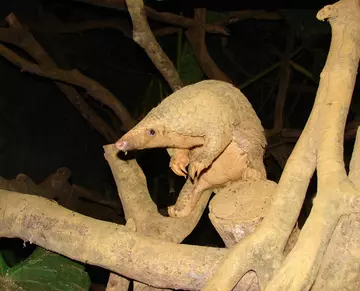ZSL
Zoological Society of London
It is only a few seconds of black and white footage, but video from a remote camera trap in Thailand has given new hope to ZSL’s team of pangolin conservationists.
One of the world’s most elusive mammal species, the critically endangered Sunda pangolin was caught on camera in Khlong Nakha Wildlife Sanctuary, Southern Thailand. It is the first known footage of a wild Sunda pangolin (Manis javanica) in this area of Thailand.
Pangolins are the world’s most illegally traded wild mammal and the finding of the Sunda pangolin in Khlong Nakha is an important first step in the team’s plans to develop standardized pangolin monitoring protocols.
The camera trap that captured the footage was set up as part of the Pangolin Conservation Initiative, a two-year project supported by Fondation Segré and Save Our Species. The project aims to monitor and protect important pangolin populations in Thailand and Cameroon, and reduce demand for pangolins and pangolin products in southern China.
ZSL Thailand’s pangolin team aims to identify pangolin hotspots and increase on-the-ground protection and law enforcement in Khlong Nakha Wildlife Sanctuary and in the four protected areas included in the Salakpra Conservation Landscape (Western Thailand), helping to secure the future of the areas' Sunda pangolins. They began field surveys in October 2015, strategically placing camera traps in areas containing evidence of pangolin activity in order to confirm pangolin presence.
Ten camera traps were placed in locations showing pangolin signs, such as claw marks on trees and digs around ant nests, and in sites containing environmental features associated with pangolins, such as tree hollows and ants’ nests. The cameras were placed both inside the protected area and in the buffer areas within 2 km of the sanctuary’s boundary. The cameras were left in the area for 30 days.

To the team’s excitement, one of the camera traps revealed a video of a pangolin climbing a Jambolan plum tree (Syzygium cumini). This particular camera was placed in the buffer area, 70 m from the boundary of Khlong Nakha Wildlife Sanctuary.
During the surveys the team noticed the hollow on the Jambolan tree, so one of the rangers climbed the tree to check for the presence of water inside it. The presence of water in the hollow and claw marks of various animals on the tree indicated that it was likely used as a water source.
The team placed a camera trap right in front of that tree, with the hope of recording a pangolin. As suspected, a pangolin climbed the tree, probably to drink water. The video shows the pangolin walking in front of the tree and starting to climb it up and then shows the pangolin climbing down and walking away.

Over the next 12 months the team will trial different methods for detecting pangolins and develop survey methodologies for assessing the status of pangolins at the site. The methods could be applied at other sites in Thailand and adapted for use elsewhere in Africa and Asia in order to identify pangolin strongholds and monitor the impact of protection on pangolin populations.
This finding has given a lot of hope to the team that pangolins are still present in the area and that the methodology used is working. There will be a lot to do in the coming months, but the team and the rangers are even more engaged in the project and very excited to survey the study area.
- Find out more about pangolin conservation
- Read about how ZSL is protecting pangolins in Central Africa
